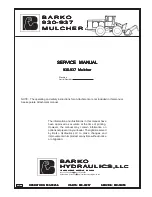
3
Dealer Pre-Delivery Instructions Grain Cart
WHEEL NUTS
Check ALL wheel nuts for correct torque setting. (5/8”-350 Ft-Lbs, 3/4”-500 Ft-Lbs, 22MM-
600 Ft-Lbs) Tighten as needed. Re-Check wheel nut torque settings during initial break in
period (during 1st, 2nd , 3rd loads, etc.), then periodically afterwards (every 10 hours of
use for first 40 hours). Keep checking wheel nut settings until wheel nuts do not loosen.
If wheel nuts loosen and damage the surface of the wheel center, it will be impossible to
keep them tight. Failure to keep the wheel nuts tight could cause considerable damage to
the grain cart and surrounding. It is the Dealer’s responsibility to have wheel nuts torqued
to specification before delivery. Damage caused by failure to keep the wheel nuts tight is
not warrantable.
HITCH
Determine the hitch style of cart to be compatible with tractor. Tractor with hammer strap
(clevis type) should be used with grain carts equipped with a single prong (spade) hitch.
Tractors equipped with a single prong hitch (no hammer strap) should be used with grain
carts equipped with a double prong (clevis) hitch.
Be sure the tractor pin is at least 1/4” smaller in diameter than the pin hole in the grain cart
hitch to ensure enough free movement when traversing through uneven terrain.
POWER TAKE-OFF
Check for adequate clearance between telescoping PTO and tractor hitch. Suggested clear-
ance is 7 inches.
Check telescoping PTO for adequate extension. With the tractor hitched to the cart on flat
level ground, the PTO should have approximately 10 inches extended from the collapsed
(shortest) length.
If equipped with a yellow Comer PTO, check the PTO slip clutch for correct adjustment for
all grain carts equipped with an 18”, 20” and 22” diameter auger. Standard spring length for
18” auger carts is 1-5/16” (overall spring length only, excluding the nut). For carts with 20”
and 22” diameter augers, tighten overall spring length to 1-1/4”. *All black Weasler clutches
are not adjustable.
HYDRAULIC CYLINDERS AND HOSES
Run all functions of the hydraulic cylinders and inspect fittings and seals for leakage. (use
cardboard or wood to check for hydraulic leaks)




































